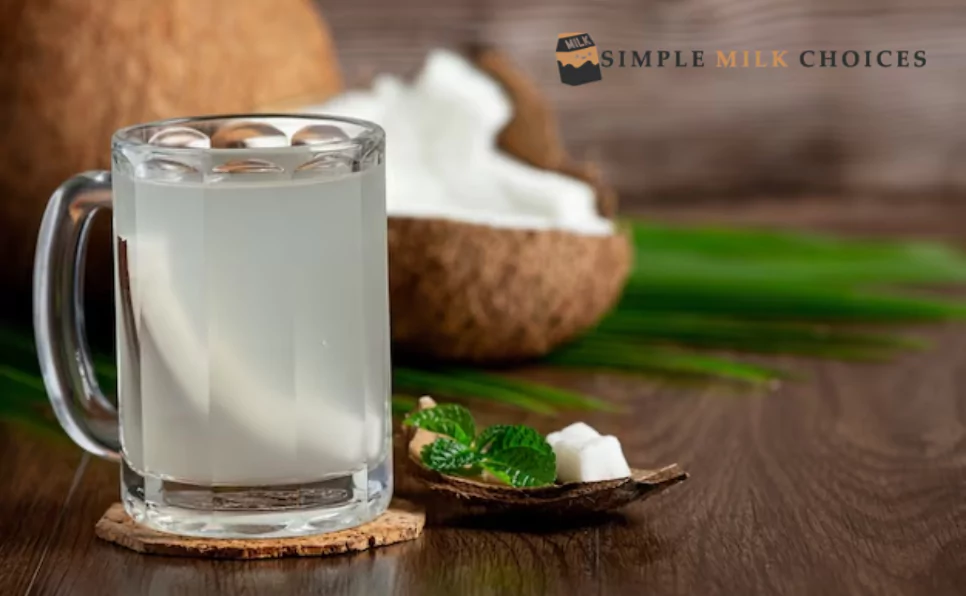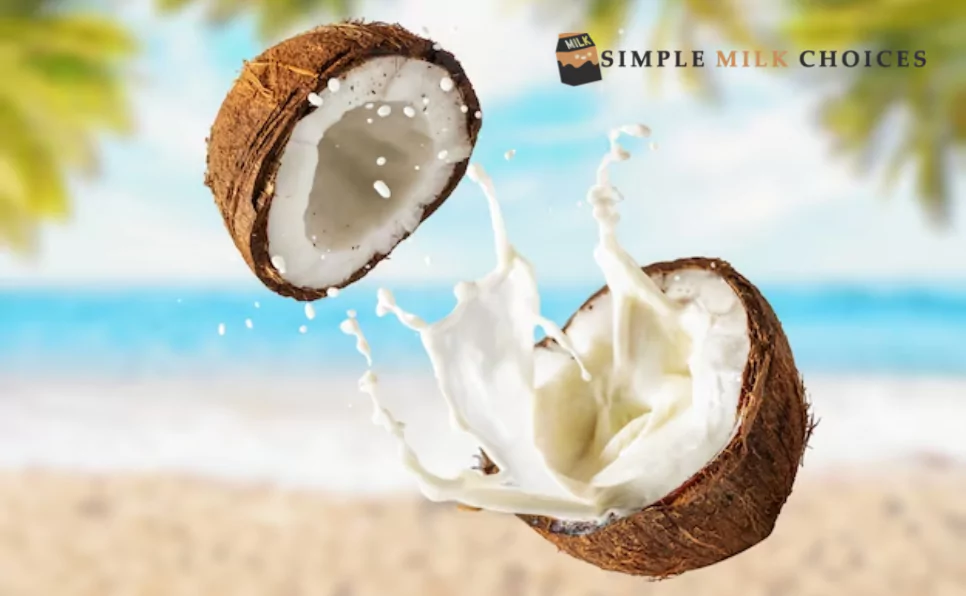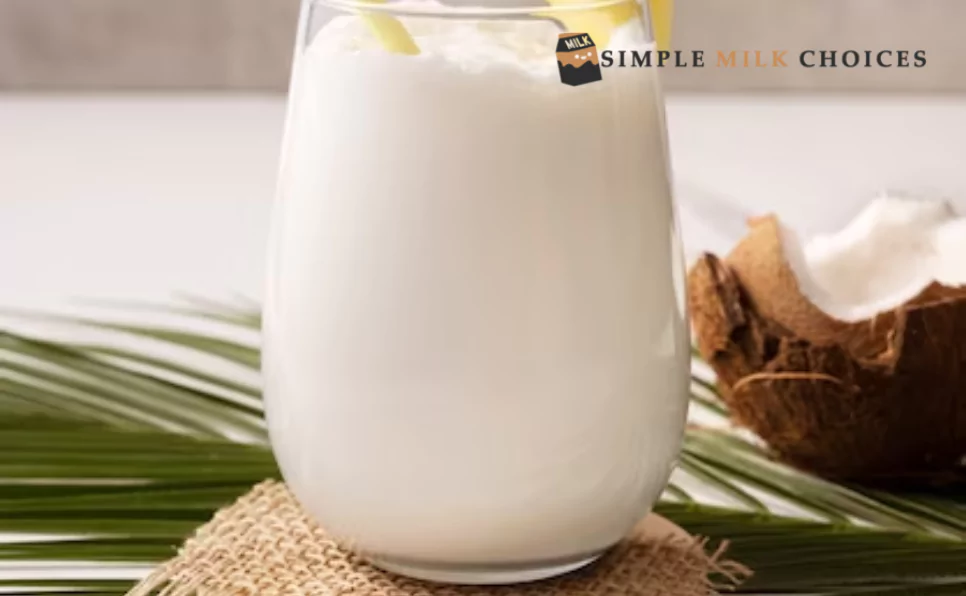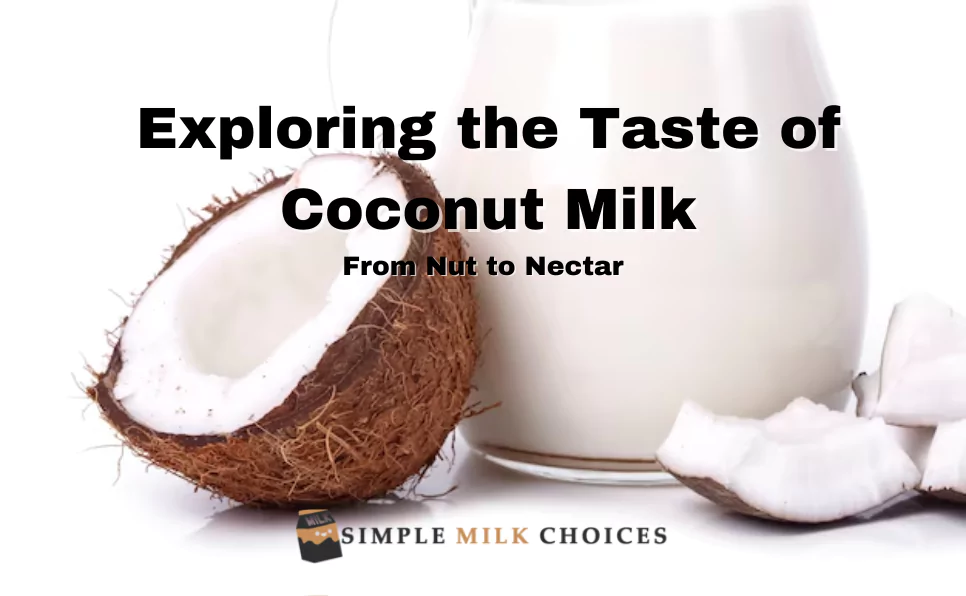Coconut milk, a culinary gem extracted from tropical coconut fruit, indicates a range of flavors that enhance foods around the world. Beyond humble appearance lies a powerhouse of taste, changing dishes with its smooth surface and specific essence.
This exploration leaves us unwinding with the substance of coconut milk. We expect to understand its taste profile and uncover the mob techniques it uses to improve recipes across different societies. From savory to sweet, its versatility exceeds all limitations.
Go along with us in exploring the nuanced flavors and sweet-smelling notes that make coconut milk a beloved ingredient. We should look into its rich taste venture and comprehend the reason why it remains a foundation in the worldwide culinary landscape.
Coconut Milk
Coconut milk is a creamy liquid removed from the ground tissue of mature coconuts. It’s frequently confused with coconut water, but they differ significantly in taste, surface, and utilization.
Composition
Texture: Creamy and dark, coconut milk has a rich consistency, looking like dairy milk but with a particular tropical embodiment.
Flavor: It conveys a somewhat sweet taste with unobtrusive nutty feelings, giving a one-of-a-kind character to dishes it’s utilized in.
Recognizing Coconut Milk from Coconut Water
Coconut Milk
- Source: Removed from the ground tissue of mature coconuts.
- Texture: Velvety, with a consistency much the same as dairy milk.
- Usage: Principally utilized in cooking and as an ingredient in different dishes because of its wealth and flavor-upgrading properties.
Coconut Water
- Source: Tracked down normally inside young, green coconuts.
- Texture: Clear and refreshing, much the same as a somewhat sweet, isotonic drink.
- Usage: Frequently consumed as a drink for hydration because of its high electrolyte content.
Production Cycle
Coconut milk is obtained through a multi-step process, including grinding the white tissue of mature coconuts, followed by extraction strategies that shift from conventional splashing and stressing to current mechanical techniques. This extraction yields a smooth liquid that turns into a staple ingredient in numerous cooking styles all over the planet.
The differentiation between coconut milk and coconut water is significant in grasping their assorted purposes in culinary applications and refreshments, separately. While coconut water fills in as a reviving drink, coconut milk goes about as a flexible fixing that raises the taste and surface of various dishes. When considering coconut milk compared to almond milk, their unique flavors and consistencies contribute differently to recipes, offering distinct nuances to culinary creations.

The Making of Coconut Milk
Making coconut milk includes a multi-step process that removes the smooth essence from the ground tissue of mature coconuts. Here’s a detailed look at the traditional and modern methods used:
Traditional or Regular Technique
1. Grinding the Coconut
- The cycle starts with the removal of the white tissue from mature coconuts.
- The tissue is then finely ground, giving it a strong texture.
2. Splashing and Separating
- The ground coconut is joined with boiling water or coconut water.
- This combination is permitted to splash, permitting the flavors and oils from the coconut to mix into the liquid.
3. Straining
- After soaking, the combination is strained through a cheesecloth or fine sifter.
- The liquid that goes through is coconut milk, which is rich in flavor and surface.
- Pressing the ground coconut helps remove the maximum amount of milk.
Modern Methods
1. Mechanical Extraction
- Automated processes include machines that press the ground coconut to remove the milk.
- This strategy is proficient at enormous scope creation and produces consistent results.
2. Blending and Straining
- Rapid mixing of ground coconut and water brings about a more prompt extraction of coconut milk.
- Stressing the combination through a fine mesh or cloth separates the liquid from the pulp.
Impact on Flavor
Traditional vs. Modern
Traditional strategies frequently bring about a more extraordinary, flavorful coconut milk. This is due to the soaking system, allowing for a deeper infusion of flavors, perfect for those seeking keto-friendly coconut milk in their culinary pursuits.
Modern procedures could offer comfort and proficiency but could deliver a somewhat lighter taste in comparison.
Culinary Applications
Coconut milk, separated through these techniques, is an important ingredient in different cooking styles.
- Curries: Adding extravagance and profundity to curries, soups, and stews
- Desserts: Upgrading the richness of pastries like coconut rice pudding or frozen yogurts
- Beverages: Utilized in tropical drinks and mixed drinks, implanting a unique coconut flavor.
Types of Coconut Milk
There are different kinds of coconut milk accessible, each with its own particular attributes and applications. We should explore them exhaustively.
1. Full-Fat Coconut Milk
Characteristics
- Richness: It contains a higher concentration of coconut cream, lending it a lavishly thick consistency.
- Flavor: Offers a strong and extraordinary coconut flavor, ideal for dishes where a velvety, full-bodied taste is desired.
- Usage: Frequently utilized in curries, sauces, treats, and mixed drinks to grant a rich and smooth surface.
2. Light Coconut Milk
Characteristics
- Lightly Produced Content: A lighter form is accomplished by weakening full-fat coconut milk with water.
- Lower Fat Substance: Contains less fat and fewer calories than full-fat coconut milk.
- Usage: Reasonable for dishes where a lighter dash of coconut flavor is liked, like soups, smoothies, and certain sauces.
3. Flavored Assortments
Characteristics
- Infusions: Upgraded with flavors like vanilla, chocolate, or other normal concentrates.
- Versatility: Adds a special change to traditional coconut milk, extending its applications in different recipes.
- Usage: Ideal for sweets, prepared merchandise, drinks, and inventive culinary tests, offering a different flavor profile.
Also Read: Can Dogs have Coconut Milk?

Considerations in Culinary Use
Cooking Applications
- Curries and Soups: Full-fat coconut milk lends a velvety surface and extravagance to these dishes, improving their flavor profile.
- Baking and Pastries: Both full-fat and enhanced assortments can lift sweets, giving a tropical touch to cakes, puddings, and frozen yogurts.
- Beverages: Light coconut milk or enhanced variants are reasonable for tropical beverages, smoothies, and mixed drinks, granting an unobtrusive coconut embodiment.
Choosing the Right Kind
- Texture: Think about the ideal consistency and extravagance of your dish.
- Flavor Power: Pick in view of whether you need a hearty coconut taste or a lighter touch.
- Well-being Considerations: Choose light renditions for lower fat substances in the event that health is a concern.
The Taste of Coconut Milk
Sweetness
The sweetness of coconut milk can change depending on different elements. Coconut variety, growth, and handling methods impact its sweetness.
Generally, mature coconuts will quite often give somewhat less sweet milk compared with younger ones, which might have a more articulated normal pleasantness.
Some handling techniques include diminishing or improving the regular sugars in coconut milk, influencing its general pleasantness.
Creaminess
Coconut milk owes its smooth surface to its high-fat substance, especially the wealth it gets from coconut cream.
This richness goes about as a characteristic emulsifier, mixing flawlessly with different fixings and adding to a smooth mouthfeel in dishes.
Nuttiness
The particular nutty embodiment of coconut milk is a component frequently compared to a tropical or fascinating flavor.
This nuttiness emerges from the intrinsic oils in coconuts, conveying a unique taste that distinguishes it from other plant-based milks.
Soft Hints of Other Flavors
While sweetness, smoothness, and nuttiness structure the center of coconut milk’s taste, they could also include unpretentious undercurrents.
Varieties in coconut milk can offer delicate hints of extra flavors like vanilla, conferring a touch of pleasantness and upgrading the general intricacy of dishes.
Floral notes or rich connotations could also be identified, adding layers of profundity to the milk’s flavor profile.
Culinary Effects
Flavor Enhancement
The mix of sweet, smooth, and nutty components in coconut milk serves as a flexible starting point for improving flavors in recipes.
It coordinates well with plenty of ingredients, improving both flavorful and sweet dishes with its distinct flavor.
Flexibility in Cooking
Coconut milk’s assorted taste profile considers culinary trial and error across different cooking styles.
It goes about as a flavor impetus, consistently mixing with flavors, spices, and different ingredients to make mind-boggling and fascinating preferences.
Coconut milk, with its nuanced taste profile enveloping sweetness, richness, nuttiness, and unobtrusive undercurrents, fills in as a foundation in worldwide food. Its capacity to improve flavors while offering a rich, smooth surface makes it a valued ingredient. From curries to sweets, its flexibility and one-of-a-kind taste hoist dishes welcome culinary exploration and growth.
Related Article: What Does Oat Milk Taste Like?
Factors Affecting Coconut Milk Taste
1. Coconut Variety and Maturity
Varietal Differences: Different coconut species show particular taste profiles, affecting the kind of subsequent milk. For example, a few coconuts could produce milk that is nuttier or better.
Maturity: More young coconuts will often contain better and more seriously reviving coconut water, while mature coconuts offer more extravagant, less sweet milk.
2. Handling Strategies
Extraction Strategies: Various strategies for removing the coconut milk—conventional splashing, mechanical squeezing, or mixing—influence its taste and consistency.
Temperature and Time: The duration of splashing or handling and the temperature at which it happens influence the mixture of flavors in the milk.
3. Added substances and Improvements
Thickening Specialists: Some industrially created coconut milk could contain thickeners or stabilizers, modifying its taste and surface.
Sugars or Flavors: Enhanced coconut milk mixed with vanilla, chocolate, or other added substances presents shifting taste profiles.
4. Bundling and Conservation
Bundling Materials: The holder or bundling utilized can impact the milk’s taste after some time, particularly if it collaborates with the milk artificially.
Safeguarding Techniques: The manner in which coconut milk is safeguarded, whether through sanitization or different procedures, can influence its taste and timeframe of realistic usability.
5. Natural Variables
Topographical Beginning: Coconuts packed in different locations express the essence of their surroundings, possibly affecting the flavor of the milk.
Soil Organization and Environment: The dirt quality and environment where coconuts develop can affect their taste because of differing supplement levels and developing circumstances.
Related Article: What Does Soy Milk Taste Like?

Culinary Considerations
Recipe Changes
Adaptability: Understanding these elements considers changes in recipes, obliging varieties in coconut milk taste to accomplish desired flavors.
Taste Inclinations: Gourmet experts and home cooks can choose coconut milk varieties in view of their favored taste profiles for various dishes.
The taste of coconut milk comes from many things, like the type of coconut used, how it’s handled, what’s added to it, and natural stuff. All these things together make the flavor of coconut milk. Valuing these variables enables people to make informed decisions while cooking and to fit recipes to suit their desired flavor profiles.
Adaptability of Coconut Milk to Culinary Delights
1. Beverages
Smoothies and Milkshakes: Coconut milk lends a rich surface and an inconspicuous tropical flavor to mixed refreshments.
Lattes and Hot cocoa: Adding coconut milk to espresso or hot cocoa offers a great turn, presenting a smooth wealth.
2. Soups and Curries
Rich Smoothness: Coconut milk fills in as a fundamental ingredient, offering a rich, smooth base for soups and curries.
Thai and Indian Cooking: Generally utilized in Thai curries (like red or green curry) and Indian dishes (for example, coconut-based kormas), it improves their profundity and flavor.
3. Sauces and Marinades
Delightful Manifestations: Coconut milk shapes a flexible medium for making tasty sauces and marinades.
Meats, Vegetables, and Fish: It supplements a wide cluster of ingredients, lifting the flavor of dishes from substantial stews to veggie sautés and fish luxuries.
4. Desserts
Tropical Guilty Pleasure: Coconut milk acquaints a tropical wind with sweets, mixing them with its distinct taste.
Frozen yogurt, Puddings, and Cakes: From smooth coconut frozen yogurt to delectable puddings and wet cakes, it elevates the pleasure of sweets.
Medical advantages of Coconut Milk
1. Supplement Rich Synthesis
Nutrients and Minerals: Coconut milk contains fundamental supplements like nutrients C, E, and B, as well as minerals like iron, magnesium, and potassium.
Solid Fats: It’s rich in sound-immersed fats, especially medium-chain triglycerides (MCTs), known for their potential medical advantages.
2. Heart Health
Great Fats: Regardless of being high in saturated fats, the MCTs in coconut milk might uphold heart well-being by expanding great cholesterol levels (HDL) and lessening terrible cholesterol (LDL) levels.
Potassium Content: The presence of potassium in coconut milk manages circulatory strain, advancing heart well-being.
3. Digestive Health
Dietary Fiber: Coconut milk contains fiber, helping assimilation and advancing stomach wellbeing.
Lauric Acid: The presence of lauric acid in coconut milk shows antimicrobial properties, possibly supporting stomach health by fighting destructive microscopic organisms.
4. Immune Support
Antioxidants: Stacked with cell reinforcements, coconut milk might assist with helping the immune system, safeguarding the body from oxidative pressure and aggravation.
Lauric Corrosive: This compound present in coconut milk could also have antimicrobial properties, supporting the battle against contamination.
5. Weight Management
MCTs and Satiation: MCTs in coconut milk can advance a sensation of totality, possibly aiding weight loss by decreasing cravings.
Conclusion: Disclosing the Distinct Taste of Coconut Milk
From its smooth lavishness to its unpretentious pleasantness and nutty hints, coconut milk epitomizes an embroidery of flavors that lift culinary manifestations higher than ever. Its flexibility stretches out a long way past being a simple ingredient—it’s a culinary excursion ready to be explored.
Embracing Coconut Milk's Special Taste
Coconut milk, with its sweet, smooth, and nutty embodiment, invites culinary exploration. Whether utilized in drinks, curries, treats, or sauces, its particular flavor profile improves dishes across a large number of foods.
We encourage you, dear readers, to set out on your own coconut milk odyssey. Explore different avenues regarding its novel desire for your recipes. Allow it to enhance your morning smoothies, add profundity to your curries, or inject a tropical curve into your treats.
Find the profundity and lavishness that coconut milk brings to your dishes. Let its smooth surface and nuanced flavors rouse your culinary imagination. As you experiment and explore, expose yourself to the vast potential outcomes this humble but exceptional ingredient offers.
Take a jump into the universe of coconut milk. Allow its taste to ship you to tropical domains and implant your feasts with a hint of fascinating charm. Embrace its flexibility, and with each dish, open another element of flavor.
Last Considerations
Coconut milk isn’t simply a culinary ingredient; it’s an experience waiting to unfold. Its taste, surface, and flexibility make it a cherished addition to kitchens around the world. Thus, embrace the experience, appreciate the flavors, and let coconut milk rethink your culinary excursion.
In your kitchen, let the lavishness of coconut milk flash your imagination and motivate wonderful gastronomic encounters.
With that, we should leave on a tasty journey, exploring the universe of coconut milk and injecting our recipes with its interesting taste profile. Cheers to culinary disclosures and the different flavors that enhance our lives!





